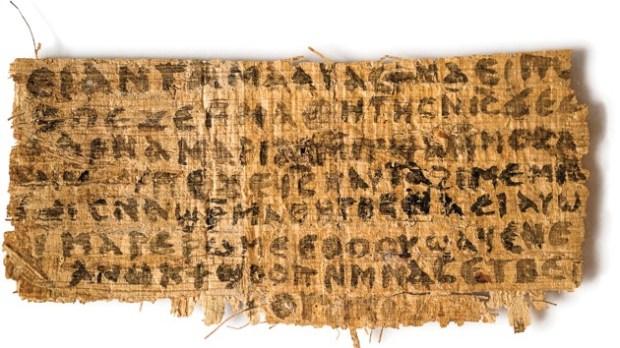When this item landed last week, it set many Facebook feeds aquiver, with the jaw-dropping investigation by Ariel Sabar into a piece of papyrus that supposedly offered, for the first time, Jesus referring to “my wife.”
Now, the historian who passionately promoted this evidence admits it doesn’t add up:
For four years, Karen L. King, a Harvard historian of Christianity, has defended the so-called “Gospel of Jesus’s Wife” against scholars who argued it was a forgery. But Thursday, for the first time, King said the papyrus—which she introduced to the world in 2012—is a probable fake. She reached this conclusion, she said, after reading The Atlantic’s investigation into the papyrus’s origins, which appears in the magazine’s July/August issue and was posted to its website Wednesday night. “It tips the balance towards forgery,” she said. Critics had argued for years that errors in Coptic grammar, similarities with the Gospel of Thomas, and other problems pointed to forgery. But King had placed her faith in the opinions of expert papyrologists, along with a series of carbon-dating and other scientific tests, at MIT, Harvard, and Columbia, that had turned up no signs of modern tampering or forgery. When I called her in March while reporting my Atlantic story, she said she was not interested in commenting on—or even hearing about—my findings before publication. Thursday afternoon, however, she called me to say the story was “fascinating” and “very helpful.”
Over at First Things, Grant Kaplan compares this boondoggle to “The DaVinci Code”:
King, an authority on early Christianity and Gnosticism who holds the Hollis Chair of Divinity at Harvard—the oldest endowed chair at our nation’s oldest university—had announced the discovery of this papyrus at a 2012 Coptic conference in Rome. She published the results of her study of the papyrus two years later in the Harvard Theological Review, a first-tier, peer-reviewed journal of religious studies. If the papyrus turned out to be a forgery, the revelation might be discrediting for King and for others who lent it credence. (As King herself said, “If it’s a forgery … it’s a career breaker.”) King, however, is not the focus of Sabar’s article. Sabar investigated the seller of the artifact—a shady German fellow named Walter Fritz, whose varied exploits and proclivities make the characters in the Da Vinci Code seem downright conventional. A university dropout and part-time pornographer, Fritz managed to fabricate a Gnostic artifact that duped one of the world’s leading experts on early, extra-canonical Christianity, plus enough of her peers to satisfy the Harvard Theological Review. How did this happen? Perhaps the appeal of Gnosticism, for a certain type of scholar, made this artifact too good to check.
I’m reminded of what an old journalism teacher told me in college: if your mother says she loves you, check it out.
Photo: Karen L. King / Harvard / AP

